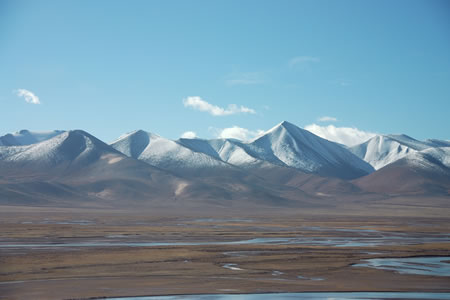English | Dutch |
|
| The highest train journey in the world | |
Lhasa (China), November 2nd 2010 |
|
This article is written by Franka and Jan, the parents of Ivonne With lots of expectations about the upcoming train journey, we walked with our backpacks to a bus stop in central Beijing, for the bus ride to Beijing’s West Railway station (Beijing Xi). We took bus 67 from Tianmen Square. It was a physical exercise to get in the bus because all the waiting Chinese ran to the door as fast as they could to secure a seat. We, with our backpacks, tried to do the same. During the ride, more and more passengers entered the bus, making it a can of sardines. It wasn’t easy to get out the bus when we arrived at the bus station. But with a little help of the weights of our backpacks, we managed to get through the crowds to one of the doors. After we entered the train station, and after the necessary security checks, we found a place on the floor to put our backpacks. The train station was very crowded and all seats were occupied. Two people stayed with the luggage, while the other two went to a small supermarket to buy some provisions for the coming days in the train. Half an hour before departure time we took our luggage and shambled with loads of other people to the T27, the train that would take us to Lhasa. We had reserved compartment 5 in carriage 6, a private compartment for the four of us. We tried to put our luggage under the seats of the train, but that wasn’t easy because of the size. In our carriage there were toilets, sinks and a samovar were we could tap hot water for tea, coffee or instant noodles. The train departed exactly at 21.30 and after we settled ourselves, we opened a bottle of Great Wall red wine to celebrate the start of our journey to Tibet. |
|
 |
|
Restocking during the stop in Xining (picture: Franka, mother of Ivonne) |
|
After a night where the sleep didn’t really want to come, we got up at eight-thirty. It was drizzly weather outside. As breakfast we took some of the provisions we bought; bread, peanut butter, jam and sausages. The sausages, bought at the Wall Mart weren’t really a success. They were way too fat, and as soon as you tried to bite in them, the fat dripped from your chin. It wasn’t difficult to throw them away. During the first part of the train ride, the landscape was still flat. But later during the first full day, it became hillier and once in a while the train took us through one of the new constructed tunnels. We saw many little villages, fields with corn and orchards with fruit trees. After 1876 kilometres, the train stopped in the city of Lanzhou, where we had some time to make some films and pictures. In Xining, at kilometre pole 2092, we stopped again and this was the city where also a lot of Tibetan people in beautiful traditional dresses and with loads of luggage entered the train. We noticed that we were riding westwards because it was dark one hour earlier then in Beijing. When we wanted to go for a sleep, the bottles and the inflatable cushion were hard, because of the lower air pressure on this higher altitude. Around three o’clock in the night and on an altitude of 2800 metres, when we passed the city of Golmud, extra oxygen was pumped into the carriages to prevent that people would get Altitude Sickness (at least that is what we heard). At four o’clock we stood up to enjoy the first snowy peaks that we saw during this journey. Not only the mountains were terrific, but also the starry sky was amazing. When the sun cam up, we saw very different scenery with mountains, lakes, rivers, yaks and sheep marching past our window. We used the binoculars very regularly to determine birds, but that wasn’t easy at this speed. We also saw wild donkeys and gazelles. At 10.29 in the morning we passed the 5000 metres and at 10.35 we crossed the highest point of this journey, the 5206 Tangglua Pass. This is also the place where we officially entered Tibet. | |
 |
|
Beautiful view on the Tibetan Plateau from the train (picture: Franka, mother of Ivonne) |
|
| Just before lunch we passed world’s highest sweet water lake, the Tsonak Lake. At 14.24 we arrive at the station of a little town called Nagu, located on an altitude of 4513 metres. The station is a new and modern building, but the surroundings are still very traditional. The name of the station was written in big Chinese characters, while the Tibetan name appeared only in small characters. The Chinese are in charge here; no doubt about that. When we left the station again we saw that there are going lots of road construction activities in this area. Tibet is getting a facelift. Slowly we were approaching the end of our train journey. We started to pack our bags again. The last part of the journey was downhill, to Lhasa located at an altitude of around 3500 metres. Noiseless, the train slid through the suburbs of Lhasa to the brand new railway station where we arrived at 18.30 in the evening. This was the end of the highest train journey in the world.
This new train track has cost 4.1 billion US-dollars. Parts of the bank on where the railway is constructed are cooled, to prevent that the tracks will sink when the frozen bank will melt during the hotter summer months. | |